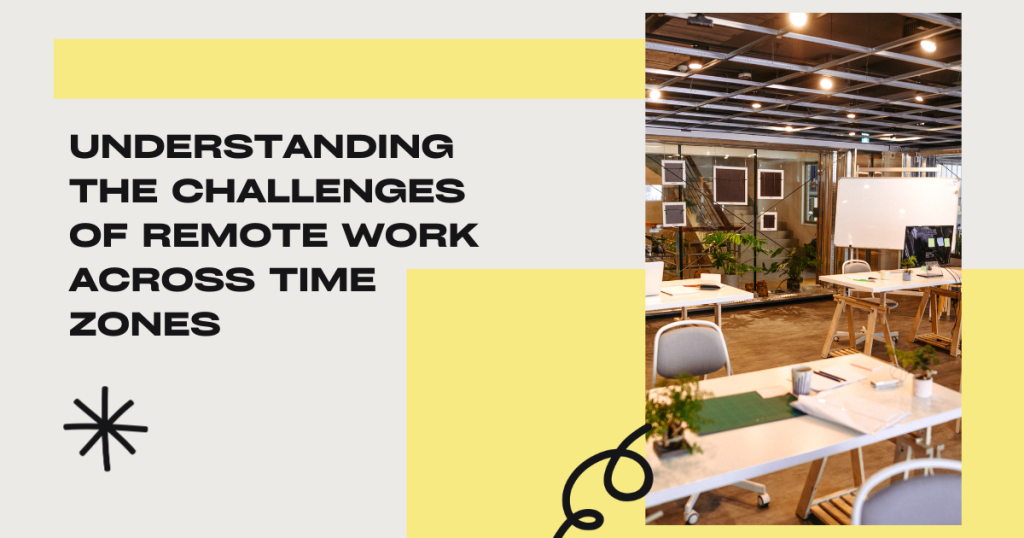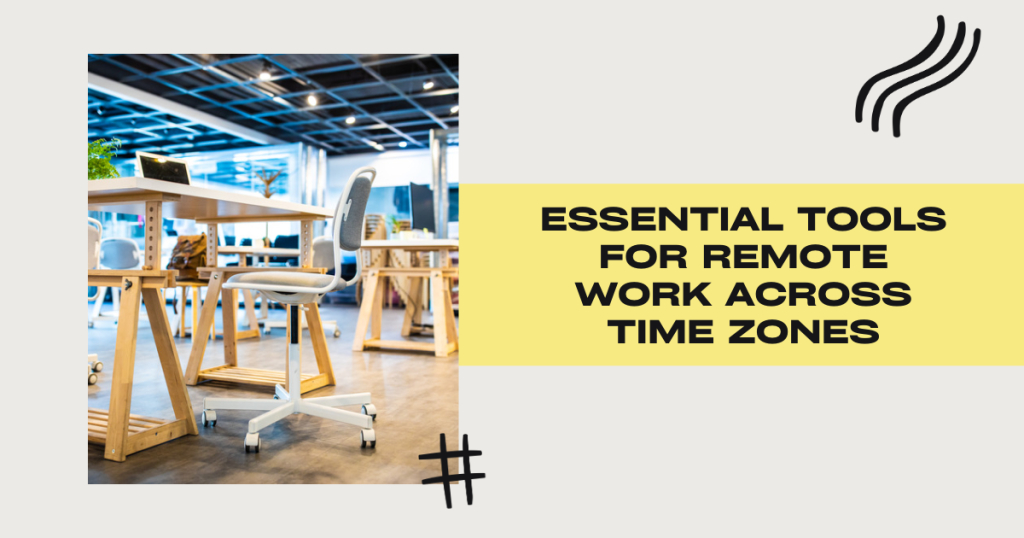
In today’s corporate world, remote work is the new norm with diverse teams that span different locations and time zones. Remarkably, as much as 70% of businesses have adopted remote working as their primary operational model.
However, amidst the numerous advantages a globally dispersed workforce offers, remote work poses a significant challenge: effectively navigating work across different time zones. Misaligned work scheduling, communication delays, limited overlapping working hours, and project management challenges—there are several challenges of remote work within diverse time zones that need to be addressed.
Recognizing this need, we have compiled this comprehensive guide. We share the best practices and indispensable tools to streamline online team management and remote work optimization. Let’s hop in!
Understanding the Challenges of Remote Work Across Time Zones

In today’s interconnected world, remote work has become increasingly prevalent, breaking down traditional barriers of geographical limitations. Where once the idea of an American employee doing remote work from Spain was fanciful, it is becoming commonplace.
However, one significant challenge remote workers face is effectively collaborating across different time zones. The diversity of time zones creates a complex web of scheduling conflicts, communication delays, and potential work disruptions.
Coordinating meetings and maintaining efficient communication can be arduous, as individuals must navigate conflicting work hours and accommodate varying personal commitments.
Recognizing and addressing the challenges of remote work across time zones is essential for fostering effective teamwork, maintaining productivity, and ensuring a harmonious work environment.
Fortunately, understanding the unique dynamics of remote work across time zones can combat all these obstacles of a diversified hybrid workplace.
Effectively navigating remote work across time zones, remote teams can transform the world into a virtual office where borders vanish, and collaboration knows no limits. Additionally, remote workers need to master the art of time management to balance productivity and work-life integration.
Best Practices for Navigating Remote Work Across Time Zones

Navigating remote work across time zones can be challenging. Still, it can be effectively managed with the right strategies and best practices. Here are the best practices you can adopt to ease the flow of your remote work across different time zones.
Establish Clear Communication Channels
Effective communication is the cornerstone of successful remote work, especially when spanning multiple time zones. You can utilize team collaboration tools that provide real-time messaging, document sharing, and project management capabilities to different team members worldwide.
Define Preferred Communication Methods
Preferred communication methods refer to the channels or modes of communication that individuals or groups prioritize or find most effective and efficient for their needs.
Different situations call for different communication methods. For urgent matters requiring immediate attention, real-time communication through platforms like video conferencing or instant messaging can bridge the gap between time zones.
On the other hand, asynchronous communication, such as email or project management tools, enables team members to collaborate at their own pace and reduces the need for constant availability.
Set Expectations for Response Times
As a successful team manager, you must overcome communication challenges and ensure smooth and timely collaboration. By setting realistic expectations, you promote a culture of accountability and foster trust among team members, regardless of their time zone differences.
Communicate and agree upon reasonable response time frames for various types of communication. This ensures that team members understand when to expect a response and reduces the risk of delayed or missed deadlines.
Create a Shared Time Zone Reference
By creating a shared time zone reference, teams can effectively communicate, collaborate and coordinate. Let’s explore how to identify team member locations and time zones and establish a master time zone reference that serves as a compass for your global workforce.
Identify Team Member Locations and Time Zones
The first step towards building a shared time zone reference is understanding where your team members are located and the time zones they operate in.
To identify the locations and time zones of your team members, you will need to gather this information from each team member individually. Once you have collected the information from each team member, you can create a centralized document or spreadsheet to store and reference the data.
Establish a Master Time Zone Reference
Crafting the master time zone reference requires meticulous attention to detail. You can create a comprehensive document or a digital dashboard where you record each team member’s location, corresponding time zone, and any relevant daylight-saving time adjustments.
Moreover, you can add a touch of creativity by incorporating visual elements such as flags, landmarks, or unique symbols representing each location. This not only enhances the visual appeal but also adds a touch of excitement to your shared reference.
Schedule Meetings and Collaboration Sessions Effectively
In a remote workplace, team members are typically located in various regions, resulting in time zone differences. This diversity makes it difficult for team managers to schedule meetings and collaborative sessions accommodating everyone.
Fortunately, employers can overcome this obstacle and encourage smooth collaboration by enhancing communication, utilizing technology and tools, and engaging in thoughtful planning. By mastering these aspects, you can efficiently arrange meetings and collaboration sessions that enhance productivity, inclusiveness, and engagement for remote team members across different time zones.
Consider Time Zone Differences
Time zones contribute to the richness of our interconnected global community. However, they also pose a challenge when it comes to scheduling meetings across borders.
To tackle this challenge, it’s essential to empathize with our team members in the furthest time zones and ensure that meeting times are reasonable for everyone. By finding a balance that acknowledges the variations in each time zone, managers can create a suitable environment for collaboration.
Utilize Meeting Scheduler Tools
Meeting scheduler tools are valuable resources for efficiently organizing and scheduling meetings with individuals or groups.
Some popular options include Calendly, Doodle, Google Calendar’s scheduling feature, Microsoft Outlook’s scheduling assistant, or scheduling tools provided by project management platforms like Asana or Trello. These tools streamline the process by eliminating the need for back-and-forth communication to find suitable meeting times.
Foster a Culture of Flexibility and Empathy
Embracing flexibility in working hours and acknowledging the challenges posed by different time zones can cultivate a thriving remote team. By fostering a culture that values adaptability and empathy, remote teams can unleash the power of productivity.
Embrace Flexibility in Working Hours
Productivity is not limited to a fixed time frame and can vary depending on individual circumstances and preferences. People have different work rhythms, energy levels, and personal commitments that can impact their productivity at different times of the day.
Empower your team to tap into their creative potential during their most productive hours. By allowing employees to have more control over their working hours, employers foster an environment for enhanced productivity and job satisfaction. Simply put, embracing flexibility allows for a well-balanced blend of work and personal life, enabling every team member to excel in their respective roles.
Show Understanding of Time Zone Challenges
You should nurture an environment where team members feel comfortable sharing their time zone constraints and concerns.
Whether adjusting meeting times, project deadlines, or promoting asynchronous communication, let understanding be the guiding star that leads your team to unity. You can also employ efficient tools and technologies, such as shared calendars and world clock applications, to ensure seamless coordination across time zones.
Maintain Documentation and Information Sharing
Maintaining proper documentation and facilitating information sharing is crucial for successful team collaboration in a remote or hybrid work environment.
Centralize Documents and Resources
In a remote workplace, where virtual landscapes have replaced traditional physical offices, centralizing documents and resources provide a solid foundation for seamless collaboration.
Imagine a virtual library where documents and resources are neatly categorized, waiting to be explored. This hub becomes the foundation for collaboration, making it easy to access information and encouraging knowledge sharing. Whether it’s a cloud storage system, a project management platform, or an intranet, this centralized database is a valuable tool for making information easily available to everyone.
Use Collaboration Tools for Real-Time Updates
Collaboration tools are powerful resources for real-time updates and seamless communication within teams or across organizations, such as Slack, Trello, Asana, Monday, Google Workspaces, etc. They enable efficient collaboration, document sharing, task management, and progress tracking.
Provide Workspaces That Boost Productivity
It’s no surprise that an employee’s work environment and office setup will have a dramatic effect on their output. Make sure your team members have an equipped workspace that will help them maintain a high level of productivity. Many remote companies go the extra mile these days and provide a stipend for a standing desk, ergonomic chair, and other essential office gear. And if your team travels frequently, know that there are flexible-term rentals you can book specifically designed for remote workers.
Essential Tools for Remote Work Across Time Zones

Let’s explore the tools that enable teams to navigate time zones effortlessly. From world clocks and time zone converters to calendar integration for seamless adjustments, these tools facilitate seamless adjustments and enhance remote collaboration.
Time Zone Conversion Tools
Time zone conversion tools allow you to stay in sync with the global clock, ensuring accurate time zone conversions at a glance. With a simple search or a click of a button, you can convert meeting times, deadlines, and important events to align seamlessly with team members across various time zones.
World Clocks and Time Zone Converters
Various world clock and time zone converter tools are available online and as mobile applications that can help you determine the current time in different locations around the world and convert between different time zones. Here are a few popular options:
- Time and Date offers a comprehensive range of tools for world clocks, time zone converters, and meeting planners. You can search for a specific location or select from a list of major cities worldwide to view the current time and time zone information and perform conversions.
- World Time Buddy is a user-friendly website that compares multiple time zones and plans meetings accordingly. It provides a visual interface with customizable clocks, and you can easily add or remove locations per your requirements.
- The Time Zone Converter is a simple tool that lets you convert between different time zones. You can simultaneously enter a specific date and time and convert it to multiple time zones.
Remember to check the accuracy of the time zone information and consider any potential daylight saving time adjustments when using these tools, as time zones can change periodically.
Calendar Integration for Time Zone Adjustments
Here are some commonly used platforms that provide calendar integration with time zone adjustments:
- Google Calendar is a popular online calendar tool with built-in features to handle time zone conversions. When creating an event, you can specify the time zone for that event, and Google Calendar will automatically adjust it for participants in different time zones. Additionally, you can enable the “World clock” feature in Google Calendar settings to view multiple time zones side by side.
- Microsoft Outlook, both the web version and desktop client, supports time zone conversions. When creating an event, you can set the time zone, and Outlook will adjust it accordingly for recipients in different time zones. You can also enable the “Time Zone” feature in Outlook settings to view additional time zones in your calendar.
- Calendly is a popular scheduling tool that integrates with various calendar applications. It allows you to create events with specific time zone settings, ensuring that meeting invitations and reminders are sent to participants in their respective time zones. Calendly automatically detects time zone differences and adjusts the available time slots accordingly.
Collaboration and Communication Platforms
In the digital realm of remote work, collaboration, and communication platforms serve as the lifeblood of effective teamwork across time zones.
These platforms provide a virtual space where team members can connect, share ideas, and collaborate seamlessly. From video conferencing tools to project management platforms and chat apps, they facilitate real-time communication and foster a sense of unity among remote teams.
Video Conferencing Tools
You can break down the distance barriers with video conferencing tools that bring face-to-face interactions to the virtual world.
Whether it’s team meetings, presentations, or brainstorming sessions, video conferencing tools enable visual and verbal communication in real-time. Here are some popular video conferencing tools:
- Zoom
- Microsoft Teams
- Google Meet
- Skype
- GoToMeeting
- BlueJeans
- Jitsi Meet
- Adobe Connect
When selecting a video conferencing tool that best suits your needs, it’s important to consider factors like participant limits, security features, ease of use, and compatibility with different devices and operating systems.
Project Management and Chat Apps
Project management and chat apps are valuable tools for organizing tasks, collaborating with team members, and facilitating effective communication.
Project Management Apps
- Trello
- Asana
- Monday.com
- Jira
- Basecamp
- Wrike
- Microsoft Planner
- Smartsheet
- ClickUp
- Notion, etc.
These project management apps and employee communication software provide features for task assignments, progress tracking, file sharing, and team collaboration, helping teams stay organized and work together efficiently.
Chat Apps:
- Slack
- Microsoft Teams
- Google Chat (part of Google Workspace)
- Discord
- Mattermost
- Twist
- Flock
- Rocket.Chat
- Telegram
- Facebook Workplace
These chat apps offer real-time messaging, file sharing, channel-based communication, and integrations with other productivity tools, allowing teams to collaborate, discuss projects, and share updates seamlessly.
Document Sharing and Version Control Tools
Efficient document sharing and version control are the cornerstones of seamless collaboration in a remote work setting.
Cloud Storage Platforms
With cloud storage, you can bid farewell to the limitations of physical storage devices and embrace the flexibility of accessing documents from anywhere at any time. This eliminates the need to worry about time zone constraints or file compatibility issues, enabling smooth collaboration and efficient document sharing.
Here are some popular cloud storage platforms:
- Google Drive
- Dropbox
- Microsoft OneDrive
- Box
- Apple iCloud Drive
- Amazon Drive
- pCloud
- Sync.com
- Mega
- SpiderOak
These cloud storage platforms vary in terms of storage capacity, collaboration features, security measures, and pricing plans.
Version Control Systems
Version control systems are software tools that help developers track changes to their codebase and collaborate on software development projects. These systems provide a centralized repository where developers can manage different versions of files, track changes, and work on code collaboratively.
Here are some popular version control systems:
- Git is the most widely used distributed version control system. It allows developers to work offline, create branches for parallel development, merge changes, and track the complete history of their codebase.
- Subversion is a centralized version control system focusing on file and directory versioning. It allows users to check out code, make changes, and commit them to a central repository.
- Mercurial is a distributed version control system similar to Git. It provides a decentralized approach to version control and offers features like branching, merging, and repository history tracking.
Each version control system has its own features, workflows, and benefits. Developers and teams should choose a version control system based on their specific needs, project requirements, and collaboration preferences.
The Wrap
Working across different time zones can make collaboration challenging. To bypass these obstacles, it is crucial to implement best practices, strategies and effectively leverage essential tools.
From time zone conversion tools, document sharing, and calendar integration to collaboration tools, communication platforms, and version control tools, we have detailed every essential tool you need to manage work effectively across varying time zones.
Utilizing these tools, you can foster a culture of flexibility and empathy, embracing personalized working hours and showing understanding of time zone challenges.
Where to next? Find monthly rentals designed for remote workers on Anyplace.






1 Comment
Pingback: Creating a Remote Work Culture in a New Location: Tips for Community Building - Anyplace Blog | Remote Work Guides, Tips, and More